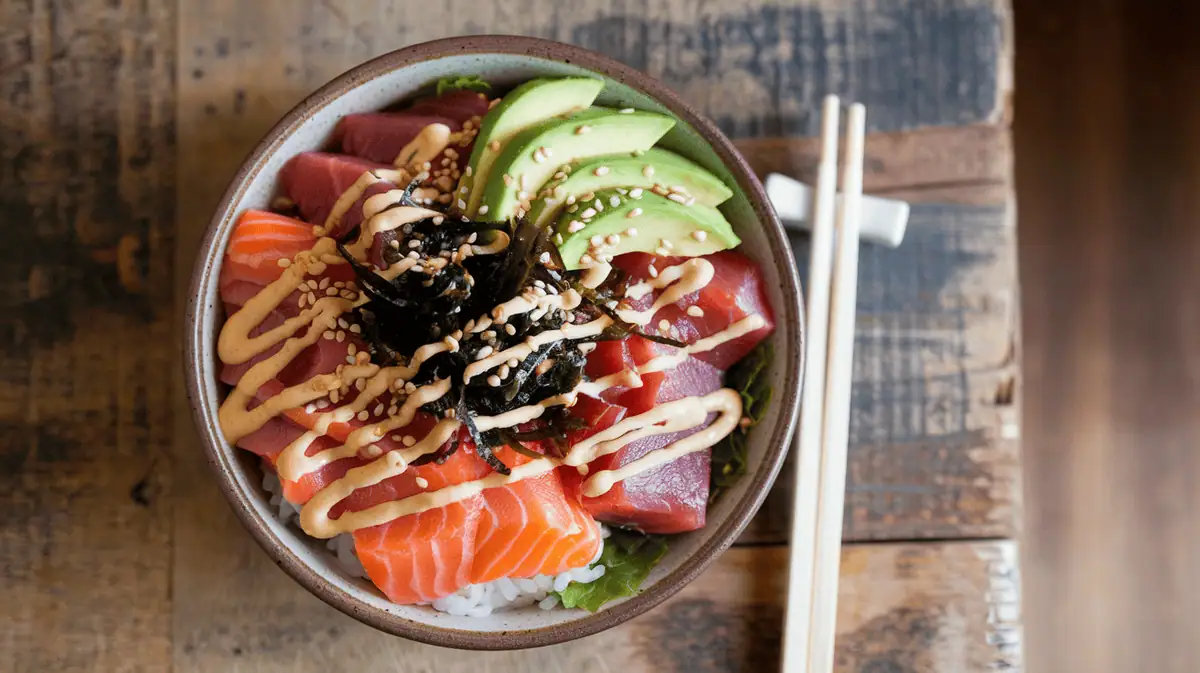The Ultimate Poké Bowl Recipe: A Fresh and Healthy Hawaiian Delight
Introduction
What is a Poké Bowl?
A Poké bowl recipe is a fresh and nutritious Hawaiian dish made with marinated raw fish, rice, and vibrant toppings. Originally from Hawaii, it has gained popularity worldwide due to its healthy ingredients and delicious flavors.
The traditional Poké bowl recipe includes ahi tuna, soy sauce, and seaweed. However, modern variations allow customization with salmon, tofu, or chicken. With the right ingredients, you can prepare a homemade Poké bowl recipe that is both satisfying and healthy.
For more ideas on fresh seafood, check out this Smoked Salmon Bagel Recipe. If you’re interested in healthy meal options, explore these Quick & Easy Salad Recipes.
Origins and Popularity
The word Poké means “to slice” in Hawaiian. Fishermen would cut fresh fish into cubes and season it with salt, seaweed, and kukui nuts. Over time, Poké bowl recipes adopted Japanese influences, introducing soy sauce and sesame oil.
Today, the Poké bowl is a global trend, found in restaurants and home kitchens. Many people love it for its nutritional value, quick preparation, and endless customization. For safe seafood preparation, read this guide on sushi-gr How to Buy Sushi-Grade Raw Fish for Sushi and Poké Bowls
History & Origins
The Hawaiian Roots of Poké
The Poké bowl recipe has deep roots in Hawaiian cuisine, dating back centuries. The word Poké means “to slice” or “to cut crosswise” in Hawaiian. Traditionally, fishermen would cut their freshly caught reef fish into cubes and season them with sea salt, seaweed, and roasted kukui nuts. This method preserved the fish while enhancing its natural flavors.
As trade and immigration influenced Hawaii, the Poké bowl recipe began incorporating ingredients from other cultures, particularly Japanese and Korean cuisines. The introduction of soy sauce, sesame oil, and chili peppers transformed the traditional Poké bowl into the flavorful dish we recognize today.
For a deeper dive into sushi-grade fish selection, check out this helpful guide: How to Buy Sushi-Grade Raw Fish for Sushi and Poké Bowls.
Traditional vs. Modern Variations
A traditional Poké bowl recipe is simple, focusing on fresh fish, sea salt, and light seasonings. Ahi tuna was the most common choice due to its availability in Hawaiian waters. The dish was often served on its own or with a simple bed of steamed rice.
In contrast, modern Poké bowls offer endless customization options. Today, you can find Poké bowl recipes that include alternative proteins like salmon, shrimp, tofu, or chicken. The base has also evolved beyond white rice, incorporating brown rice, quinoa, or mixed greens to cater to various dietary needs.
Toppings have expanded to include avocado, edamame, crispy onions, spicy mayo, and ponzu sauce, creating a fusion of textures and flavors. These contemporary adaptations make Poké bowls a perfect blend of tradition and innovation.
For more fresh and healthy meal ideas, check out these Quick & Easy Salad Recipes. If you love seafood dishes, you may also enjoy a Smoked Salmon Bagel, another delicious way to enjoy high-quality fish.
With its rich history and continuous evolution, the Poké bowl recipe remains a beloved dish that combines freshness, simplicity, and adaptability. In the next section, we’ll explore the essential ingredients that make the perfect homemade Poké bowl.
Essential Ingredients
Core Components of a Poké Bowl
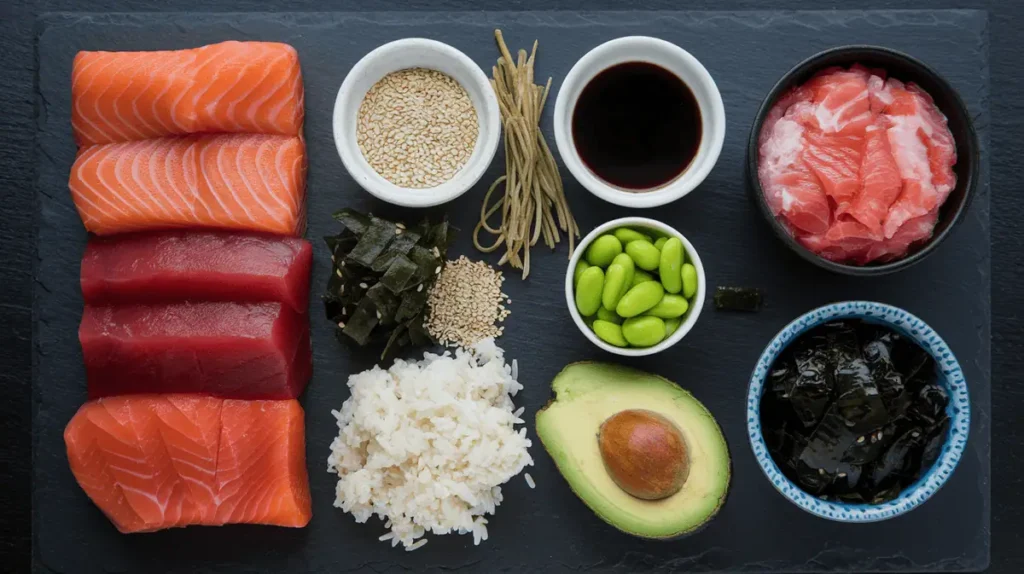
A well-balanced Poké bowl recipe relies on four essential components: fresh fish, a flavorful base, a variety of toppings, and delicious sauces. Each element contributes to the dish’s texture, taste, and overall appeal. Understanding how to choose the right ingredients ensures a perfect homemade Poké bowl every time.
Fresh Fish, Base, Toppings, and Sauces
Fresh Fish
The star of any Poké bowl recipe is the fish. Traditionally, ahi tuna is the most common choice due to its firm texture and mild flavor. However, other options, such as salmon, yellowtail, or shrimp, work well too. When selecting fish, it is crucial to buy sushi-grade seafood to ensure freshness and food safety. For guidance on purchasing high-quality raw fish, visit How to Buy Sushi-Grade Raw Fish.
For those who prefer alternatives to raw fish, cooked proteins like grilled shrimp, teriyaki chicken, or tofu provide excellent substitutes. These options allow for greater flexibility while maintaining the integrity of a Poké bowl.
Base
The base of a Poké bowl serves as the foundation that complements the toppings and sauces. White rice is the most traditional choice, offering a neutral backdrop for the marinated fish. However, brown rice, quinoa, or mixed greens provide healthier alternatives. Each base affects the overall texture and flavor balance, making it essential to choose based on personal preference.
For those looking for more healthy meal ideas, Quick & Easy Salad Recipes provide additional inspiration for base variations.
Toppings
Toppings add texture, color, and nutritional benefits to a Poké bowl recipe. Popular choices include avocado, seaweed, edamame, pickled ginger, cucumber, and crispy onions. Each topping enhances the dish by contributing different flavors, from creamy to crunchy. Choosing the right combination ensures a balanced and satisfying meal.
For another seafood-based dish packed with fresh ingredients, try a Smoked Salmon Bagel, which features complementary flavors similar to those found in Poké bowls.
Sauces
The sauce ties all the ingredients together, adding depth and umami to the Poké bowl. Traditional choices include soy sauce, ponzu, sesame oil, and wasabi mayo. Meanwhile, modern variations incorporate spicy mayo, sriracha, and teriyaki glaze for extra heat and richness.
A perfectly balanced Poké bowl recipe combines these four essential components, ensuring every bite is fresh, flavorful, and satisfying. In the next section, we’ll explore how to choose the best fish for a homemade Poké bowl.
Choosing the Right Fish
Best Fish for Poké Bowls
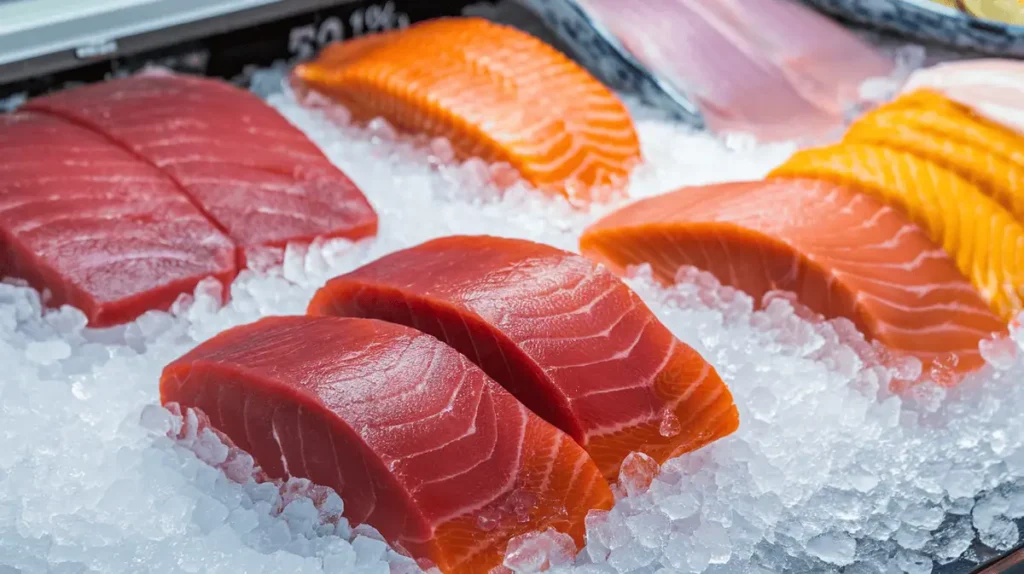
The choice of fish significantly impacts the quality and taste of any Poké bowl recipe. Traditionally, ahi tuna is the most popular option due to its rich flavor and firm texture. However, other fish varieties, such as salmon, yellowtail, and albacore, also work well. Selecting high-quality, sushi-grade fish is essential for both taste and safety.
When purchasing seafood, freshness is a priority. Always source from reputable fish markets or specialty stores. For a detailed guide on selecting safe raw fish, refer to How to Buy Sushi-Grade Raw Fish.
For those who prefer alternative seafood options, shrimp, scallops, and octopus offer unique textures and flavors. Each type of seafood contributes to a different Poké bowl experience, allowing for variety in every bite.
Raw vs. Cooked Options
A traditional Poké bowl recipe features raw fish, which provides a fresh and delicate taste. The most common raw options include:
- Ahi Tuna – A classic choice with a deep red color and buttery texture.
- Salmon – Rich in omega-3 fatty acids, offering a smooth, mild flavor.
- Yellowtail (Hamachi) – Slightly sweet with a firm, satisfying bite.
While raw fish is the foundation of most Poké bowl recipes, some prefer cooked alternatives. Cooked options are ideal for those who are new to eating raw seafood or have dietary restrictions. Excellent choices include:
- Grilled Shrimp – A lightly seasoned protein that complements various sauces.
- Teriyaki Chicken – A flavorful, non-seafood alternative.
- Tofu – A plant-based option that absorbs marinades beautifully.
For those who enjoy seafood but prefer it smoked, consider trying a Smoked Salmon Bagel, which provides a different yet equally satisfying taste experience.
Choosing the right fish, whether raw or cooked, ensures that every Poké bowl recipe remains delicious and customizable. In the next section, we will explore alternative proteins for those looking to diversify their Poké bowl options.
Alternative Proteins
Plant-Based & Non-Fish Alternatives
While a traditional Poké bowl recipe is built around raw fish, many delicious alternatives exist for those who prefer non-seafood or plant-based options. Whether for dietary preferences, allergies, or personal taste, substituting fish with high-protein alternatives ensures that everyone can enjoy a Poké bowl while maintaining its signature flavors and textures.
For a successful Poké bowl recipe without seafood, choosing the right protein is crucial. Popular alternatives include tofu, chicken, tempeh, and legumes, all of which absorb marinades well and pair beautifully with traditional Poké sauces.
Tofu, Chicken, and Beyond
Tofu
In plant-based Poké bowls, tofu stands out for its mild flavor and ability to absorb sauces. The firm variety is ideal since it retains its texture when marinated in soy sauce, sesame oil, or ponzu. To enhance its taste and consistency, baking or grilling creates a subtle crispiness.
Another excellent alternative is tempeh, which has a firmer texture and a slightly nutty flavor. Both tofu and tempeh provide a protein-rich foundation, making them satisfying options for a Poké bowl recipe.
Chicken
For those who do not consume raw fish but still want a protein-packed Poké bowl, chicken is a fantastic substitute. Grilled, teriyaki-glazed, or poached chicken complements traditional Poké toppings and sauces. Marinating chicken in soy sauce, ginger, and garlic enhances its umami flavor, making it a great fit for a Poké bowl recipe.
For another delicious chicken-based meal, check out this Perfect Lemon Chicken Recipe, which pairs well with many Poké-style ingredients.
Beyond Seafood: Other Protein Options
Additional alternatives for a Poké bowl recipe include:
- Edamame – A protein-rich, plant-based option that adds a fresh, slightly sweet taste.
- Hard-boiled eggs – A simple but effective way to incorporate protein.
- Chickpeas or black beans – Perfect for a high-fiber, vegetarian-friendly Poké bowl.
For more plant-based meal inspiration, explore these Quick & Easy Salad Recipes, which share many ingredients with Poké bowls.
With a variety of alternative proteins, the Poké bowl recipe remains versatile, offering options that suit every dietary preference. In the next section, we will look at how to choose the perfect base for a well-balanced Poké bowl.
Selecting the Perfect Base
Rice, Greens, and More
The base of a Poké bowl recipe plays a crucial role in balancing flavors and textures. Traditionally, sushi rice is the most common choice, but many alternatives exist to cater to different dietary needs. Whether using rice, greens, or grains, the right base enhances the overall experience of a homemade Poké bowl.
Some people prefer steamed white rice, which provides a neutral flavor that complements marinated fish and sauces. Others opt for brown rice, quinoa, or mixed greens for a healthier variation. Choosing the right base depends on both personal preference and nutritional goals.
For more healthy bowl ideas, explore these Quick & Easy Salad Recipes, which include fresh, vibrant ingredients similar to those in Poké bowls.
Pros and Cons of Each
Each base offers unique benefits and potential drawbacks:
- White Rice: The classic base for a Poké bowl recipe, it has a mild flavor and slightly sticky texture, allowing ingredients to blend well. However, it contains fewer nutrients than whole grains.
- Brown Rice: A fiber-rich alternative that adds a nutty taste and extra nutrients. It is less sticky, which may slightly change the texture of the Poké bowl.
- Quinoa: A high-protein, gluten-free option that brings a light, fluffy consistency. While nutritious, it lacks the traditional texture of sushi rice.
- Mixed Greens: A great low-carb choice that makes the Poké bowl recipe lighter and fresher. However, it does not provide the same structure as rice-based bowls.
Selecting the perfect base ensures a well-balanced Poké bowl that aligns with both flavor preferences and nutritional goals.
Delicious Sauces
Signature Poké Bowl Sauces
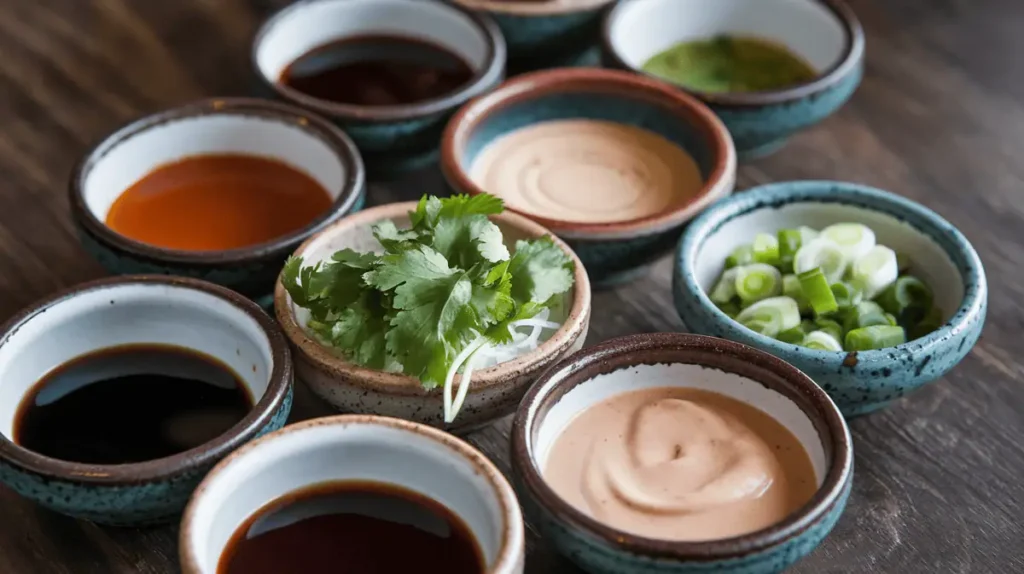
The sauce is what ties together all the ingredients in a Poké bowl recipe, enhancing both flavor and texture. A well-chosen dressing elevates the dish, bringing balance and complexity. The most popular options fall into three main categories: soy-based, spicy, and creamy sauces.
Each variety complements different ingredients, making it easy to customize the Poké bowl based on personal taste. A good sauce selection ensures that every bite is rich, flavorful, and satisfying.
Soy-Based, Spicy, and Creamy Options
- Soy-Based Sauces: These provide a deep umami flavor that enhances the natural taste of the fish. Popular options include classic soy sauce, ponzu (a citrus-infused soy sauce), and tamari (a gluten-free alternative).
- Spicy Sauces: For those who enjoy heat, sriracha mayo, gochujang sauce, and chili oil add a bold kick to a Poké bowl recipe. Spicy elements contrast beautifully with the freshness of the other ingredients.
- Creamy Sauces: A smooth, rich texture can complement both traditional and modern Poké bowls. Common choices include spicy mayo, sesame dressing, and wasabi aioli.
Selecting the right sauce ensures that every Poké bowl is flavorful and well-balanced. The next section will explore the best toppings and garnishes to complete the dish.
Toppings and Garnishes
Must-Have Toppings
Toppings add texture, color, and layers of flavor to any Poké bowl recipe. A well-balanced selection enhances the dish, making it both visually appealing and delicious. Whether opting for crunchy, fresh, or exotic toppings, each ingredient contributes to the overall experience of a homemade Poké bowl.
Traditional toppings include avocado, seaweed, and cucumber, while modern variations introduce bold flavors like pickled vegetables, spicy jalapeños, and crispy onions. The right combination of toppings ensures that every bite is dynamic and satisfying.
For more fresh ingredient ideas, explore these Quick & Easy Salad Recipes, which feature many of the same vibrant components found in Poké bowls.
Crunchy, Fresh, and Exotic Choices
- Crunchy Toppings: Adding a crispy texture enhances the contrast between the soft base and tender fish. Popular choices include crispy onions, toasted sesame seeds, tempura flakes, and crushed macadamia nuts.
- Fresh Toppings: Fresh ingredients brighten the flavors of a Poké bowl recipe. Top choices include avocado, cucumber, shredded carrots, radish slices, and edamame. These add a balance of creaminess and crispness.
- Exotic Choices: Unique toppings introduce bold flavors and a creative twist. Pickled ginger, tobiko (fish roe), jalapeños, and mango cubes elevate a Poké bowl with extra bursts of flavor.
The right combination of toppings ensures a vibrant, well-rounded Poké bowl that satisfies both texture and taste preferences.
Step-by-Step Recipe
How to Make a Poké Bowl at Home
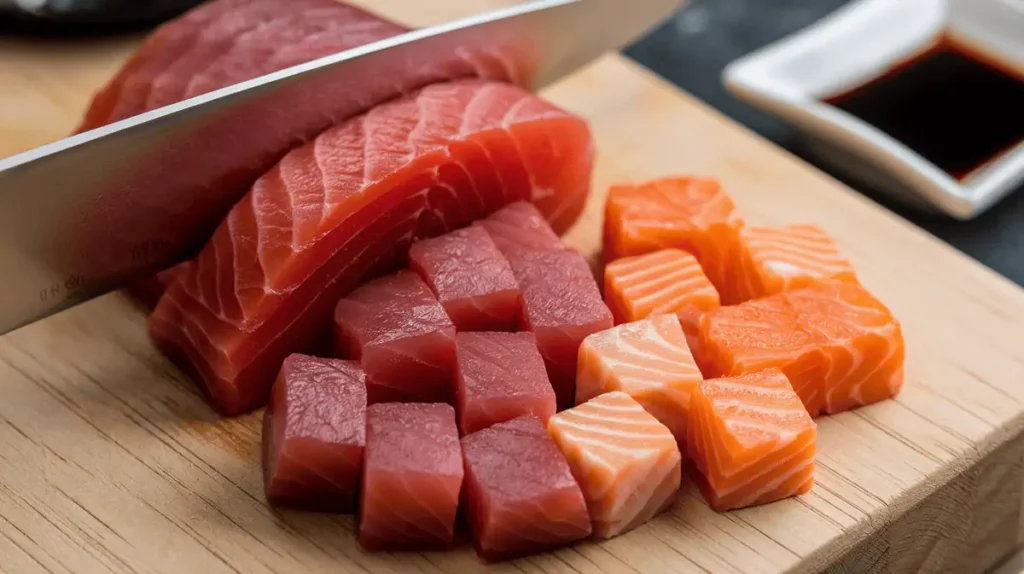
Creating a homemade Poké bowl recipe is simple and rewarding. With fresh ingredients and the right preparation, it is easy to enjoy an authentic Poké bowl from the comfort of your kitchen. The key to success lies in properly prepping the ingredients and assembling them in a way that enhances both taste and presentation.
Ingredient Prep and Assembly
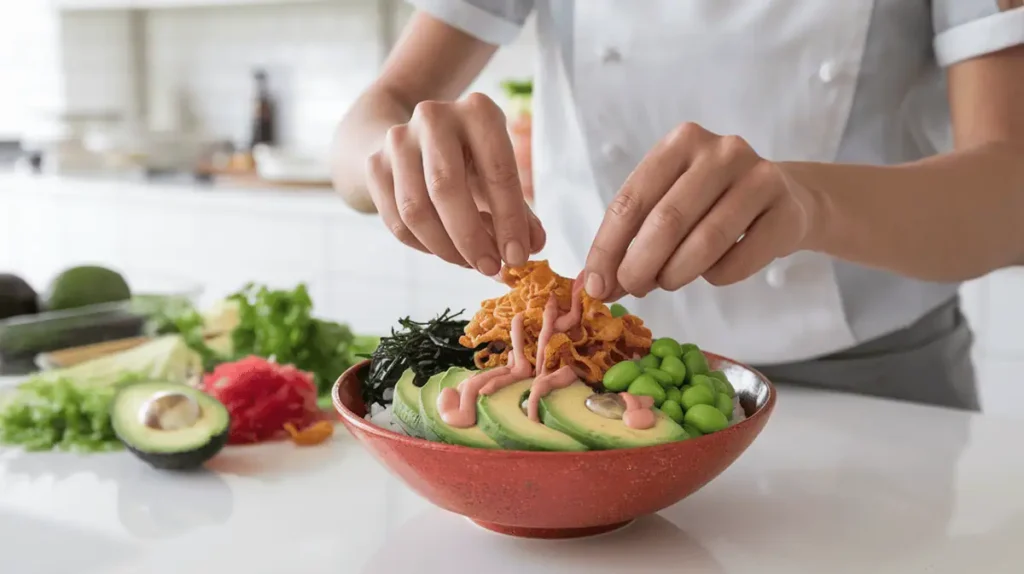
Ingredients:
- Protein: 200g sushi-grade tuna or salmon, diced
- Base: 1 cup sushi rice, brown rice, or mixed greens
- Toppings: Avocado, cucumber, edamame, shredded carrots, sesame seeds, pickled ginger
- Sauces: 2 tbsp soy sauce, ponzu, or spicy mayo
- Garnishes: Tobiko, nori strips, or tempura flakes
Instructions:
- Prepare the Base – If using rice, rinse and cook according to package instructions. Let it cool slightly before serving.
- Marinate the Fish – Combine diced tuna or salmon with soy sauce, sesame oil, and a dash of rice vinegar. Let it sit for 10–15 minutes to absorb flavors.
- Chop and Arrange Toppings – Dice avocado, cucumber, and carrots into small pieces for easy layering.
- Assemble the Bowl – Start with the base, then add the marinated fish. Arrange toppings around the bowl for a colorful presentation.
- Drizzle with Sauce – Finish with spicy mayo, ponzu, or a soy-based dressing. Sprinkle with sesame seeds or tempura flakes for extra texture.
For another seafood-inspired dish, try this Smoked Salmon Bagel Recipe, which pairs well with many Poké bowl ingredients.
With the right ingredients and preparation, making a Poké bowl recipe at home is both easy and customizable. The next section will explore ways to personalize your bowl for different dietary needs.
Customizing Your Bowl
Tailoring to Dietary Needs
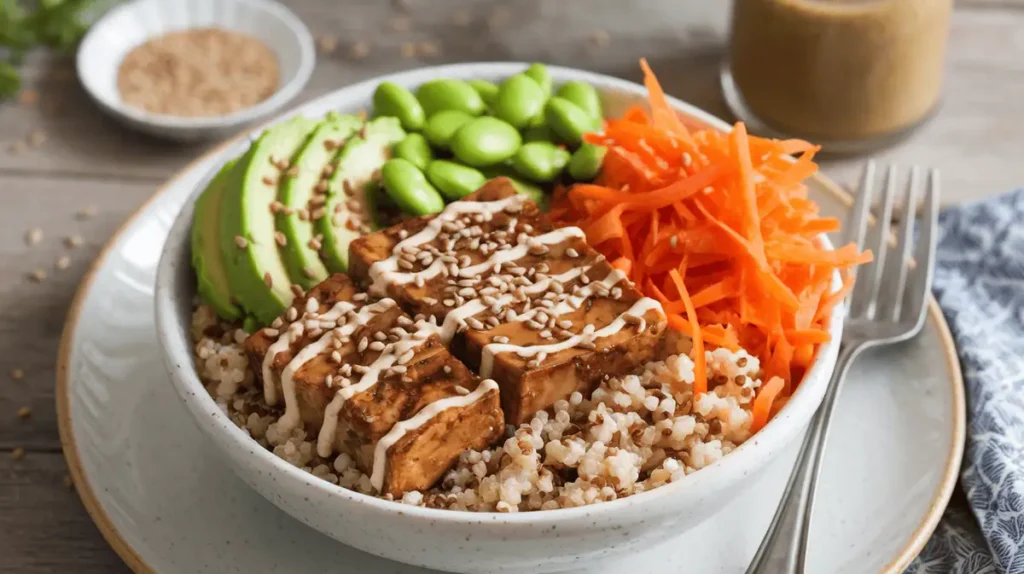
A Poké bowl recipe is highly adaptable, making it easy to adjust based on dietary preferences and nutritional goals. Whether following a low-carb, vegan, or keto-friendly diet, simple ingredient swaps allow for a customized and balanced meal.
By selecting the right base, protein, and toppings, anyone can enjoy a homemade Poké bowl without compromising dietary needs. Thoughtful ingredient choices ensure that the dish remains flavorful, satisfying, and nutritious.
Low-Carb, Vegan, and Keto-Friendly Variations
- Low-Carb Options: Instead of white rice, opt for cauliflower rice, zucchini noodles, or mixed greens. These alternatives reduce carbohydrates while maintaining texture and freshness.
- Vegan Variations: Replace raw fish with tofu, tempeh, or marinated mushrooms. Add edamame, avocado, and seaweed for protein and healthy fats. A drizzle of sesame or ponzu sauce enhances the umami flavor.
- Keto-Friendly Adaptations: Choose leafy greens instead of rice, and focus on high-fat toppings such as avocado, macadamia nuts, and sesame seeds. Opt for salmon or tuna as the protein source and use a soy-based or spicy mayo sauce.
For more fresh, plant-based meal ideas, check out these Quick & Easy Salad Recipes, which share many of the same ingredients found in Poké bowls.
Customizing a Poké bowl recipe ensures that it fits any lifestyle while maintaining its signature freshness and flavor.
Health Benefits
Why Poké Bowls Are a Nutritious Choice
A Poké bowl recipe offers a well-balanced meal packed with lean protein, healthy fats, and essential nutrients. The combination of fresh fish, vegetables, and wholesome grains makes it an excellent choice for overall health. By incorporating a variety of ingredients, a Poké bowl provides sustained energy and supports overall well-being.
The nutritional profile varies based on ingredient selection, but the dish is naturally rich in essential vitamins, minerals, and antioxidants. Choosing the right components ensures that every bite is as nourishing as it is delicious.
Protein, Omega-3s, and Antioxidants
- High-Quality Protein: The raw fish, tofu, and legumes used in Poké bowls provide a high-protein meal that supports muscle growth, metabolism, and overall health.
- Omega-3 Fatty Acids: Found in salmon, tuna, and avocado, omega-3s promote heart health, brain function, and reduced inflammation.
- Antioxidant-Rich Ingredients: Toppings like seaweed, pickled ginger, and edamame provide antioxidants that help protect against cell damage and support the immune system.
For another high-protein seafood dish, try this Smoked Salmon Bagel Recipe, which shares many of the same nutritional benefits found in Poké bowls.
By combining fresh ingredients with nutrient-dense components, a Poké bowl recipe delivers a wholesome, satisfying meal that nourishes the body and delights the taste buds.
Best Pairings
What to Serve with Your Poké Bowl
A Poké bowl recipe is a complete meal on its own, but pairing it with the right drinks and side dishes enhances the overall experience. The key is to choose complementary flavors that balance the fresh, umami-rich ingredients of the Poké bowl without overpowering them.
Lighter beverages and fresh, simple side dishes work best. Whether serving a traditional Poké bowl or a customized version, selecting the right pairings ensures a satisfying and well-rounded meal.
Drinks and Side Dishes
Best Drinks for a Poké Bowl
- Green Tea – A light, antioxidant-rich tea that enhances the clean flavors of a Poké bowl without overpowering the dish.
- Coconut Water – Naturally hydrating with a hint of sweetness, it complements the freshness of Poké bowl ingredients.
- Sparkling Water with Citrus – A refreshing option that cleanses the palate between bites.
- Cold Sake – For those who enjoy an alcoholic pairing, dry sake balances the umami flavors of soy sauce and seafood.
Perfect Side Dishes
- Miso Soup – A classic Japanese starter that provides warmth and depth of flavor.
- Seaweed Salad – A light, nutrient-rich dish that complements the textures of a Poké bowl.
- Steamed Edamame – A high-protein, lightly salted side that pairs well with soy-based sauces.
- Pickled Vegetables – A crunchy and tangy contrast to the soft textures of fish and rice.
For additional healthy meal inspiration, check out these Quick & Easy Salad Recipes, which feature fresh, vibrant ingredients similar to those found in Poké bowls.
Pairing a Poké bowl recipe with the right sides and drinks ensures a complete, flavorful dining experience.
Common Mistakes
Poké Bowl Pitfalls to Avoid
A Poké bowl recipe is simple to prepare, but certain mistakes can affect its freshness, texture, and overall taste. From selecting the right ingredients to ensuring proper storage, avoiding these common errors guarantees the best possible homemade Poké bowl.
Choosing Fresh Ingredients, Proper Storage
Mistake #1: Using Low-Quality Fish
One of the most crucial aspects of a Poké bowl recipe is selecting sushi-grade fish. Using non-sushi-grade seafood can affect both flavor and food safety. Always buy from a trusted source. For guidance, refer to How to Buy Sushi-Grade Raw Fish.
Mistake #2: Over-Marinating the Fish
While marinating enhances flavor, leaving fish in sauce for too long can break down its texture. A 15–30 minute marinade is ideal to maintain freshness.
Mistake #3: Improper Storage
Raw fish must be stored correctly to prevent spoilage. Keep it refrigerated at 32°F (0°C) and consume it within 24 hours. If using leftovers, store toppings and fish separately to maintain texture.
Mistake #4: Overloading Toppings
A well-balanced Poké bowl should highlight the natural flavors of the fish. Overloading with too many toppings or sauces can make the dish heavy and unbalanced. Instead, focus on a few complementary ingredients.
For another seafood-based recipe with fresh, high-quality ingredients, try this Smoked Salmon Bagel Recipe.
By avoiding these common pitfalls, every Poké bowl recipe turns out fresh, flavorful, and perfectly balanced.
FAQs
Frequently Asked Questions
A Poké bowl recipe is simple to prepare, but many people have questions about ingredient selection, storage, and best practices. Understanding how to properly handle raw fish, store leftovers, and enhance flavors ensures that every homemade Poké bowl is both delicious and safe to eat.
Preparation, Storage, and Best Practices
1. How do I choose the best fish for a Poké bowl?
Always use sushi-grade fish from a reputable source. Look for fresh ahi tuna, salmon, or yellowtail, ensuring it has a clean scent and vibrant color. If unsure, refer to this guide: How to Buy Sushi-Grade Raw Fish.
2. Can I use frozen fish for a Poké bowl?
Yes, frozen fish can be used as long as it is labeled sushi-grade. Thaw it slowly in the refrigerator for the best texture and flavor. Avoid using fish that has been thawed and refrozen.
3. How long can a homemade Poké bowl be stored?
For the best quality, consume a Poké bowl within 24 hours. Store raw fish and toppings separately from the rice to maintain freshness. Keep fish refrigerated at 32°F (0°C) until ready to serve.
4. Can I make a Poké bowl in advance?
Yes, but keep the ingredients separate. Prepare the base, toppings, and sauces ahead of time, then assemble just before serving. This prevents sogginess and keeps the dish fresh.
5. What are the best substitutes for raw fish?
For a cooked Poké bowl, try grilled shrimp, teriyaki chicken, or baked tofu. These alternatives maintain the flavors of a traditional Poké bowl recipe while catering to different dietary preferences.
6. What is the best rice for a Poké bowl?
Sushi rice is the most common base, but brown rice, quinoa, and mixed greens are great alternatives for different dietary needs. For more healthy base ideas, check out these Quick & Easy Salad Recipes.
7. How can I enhance the flavor of my Poké bowl?
Use fresh ingredients, marinate proteins for at least 15 minutes, and balance textures with crunchy toppings like sesame seeds or crispy onions. Experiment with different sauces like ponzu, spicy mayo, or sesame dressing for added depth.
By following these best practices, every Poké bowl recipe turns out fresh, flavorful, and satisfying.
Conclusion
Enjoying Your Homemade Poké Bowl
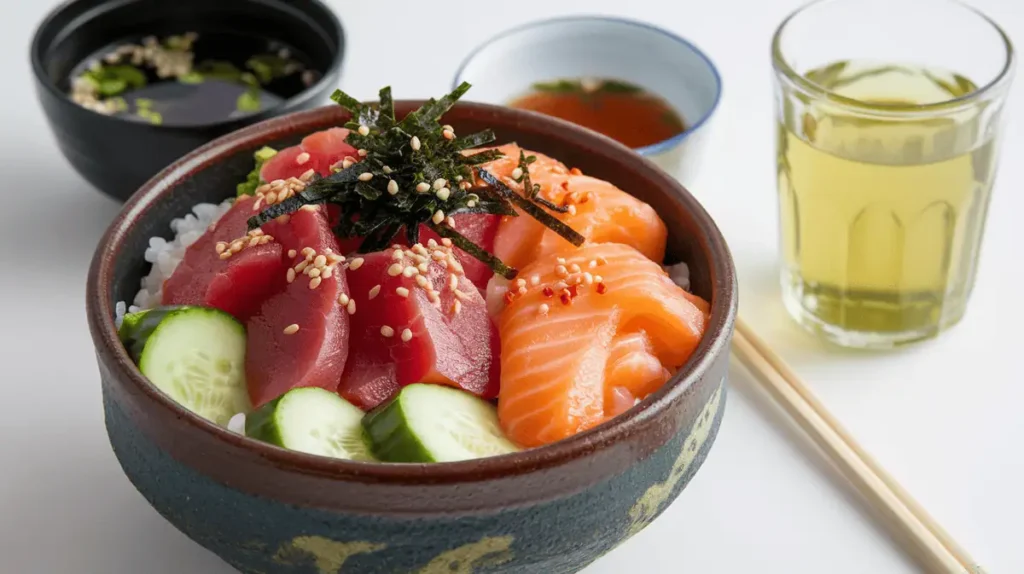
A Poké bowl recipe is more than just a meal—it’s a fresh, flavorful, and highly customizable dish that brings together the best of Hawaiian and Japanese cuisine. By selecting high-quality ingredients, balancing textures, and using the right sauces, anyone can create a homemade Poké bowl that rivals restaurant-quality versions. Whether you prefer a traditional ahi tuna Poké bowl or a modern variation with alternative proteins, the possibilities are endless.
With the right combination of fresh fish, a flavorful base, crunchy toppings, and a delicious sauce, each bite delivers the perfect balance of umami, freshness, and texture. Plus, the ability to tailor a Poké bowl recipe to dietary preferences—whether low-carb, vegan, or keto—makes it a versatile and healthy meal choice.
Final Tips for the Perfect Bowl
- Always use sushi-grade fish to ensure freshness and safety. If raw fish isn’t an option, substitute with grilled shrimp, teriyaki chicken, or tofu.
- Marinate proteins for at least 15 minutes to enhance flavor, but avoid over-marinating to maintain texture.
- Choose the right base based on personal preference—sushi rice for tradition, greens for a lighter option, or quinoa for added protein.
- Balance flavors and textures by combining soft ingredients like avocado with crunchy toppings such as sesame seeds, tempura flakes, or pickled vegetables.
- Store ingredients properly by keeping raw fish refrigerated and assembling the bowl just before serving.
For another delicious seafood dish, check out this Smoked Salmon Bagel Recipe, which features fresh ingredients similar to those in a Poké bowl.
By following these tips, making a homemade Poké bowl recipe becomes a simple yet rewarding experience. Experiment with different flavors, try new toppings, and most importantly, enjoy the process of creating a fresh and nutritious meal!

